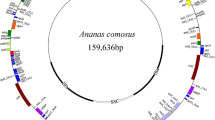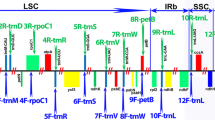Abstract
We recently determined the complete sequence of the sugarcane chloroplast genome. Here, we have used the information for a comprehensive phylogenetic analysis of the genus Saccharum, using all six species (13 accessions). The polymorphisms between sugarcane and maize in 26 chloroplast genome regions were used for the analysis. In 18 of the 26 regions (a total of 5,381 bp), we found 41 mutations involving 17 substitutions, three inversions, six insertion/deletion mutations, and 15 simple sequence repeat length polymorphisms. Based on these results, we calculated a phylogenetic tree of the genus Saccharum, in which all six species are clearly separated. By the analysis, (1) S. sinense and S. barberi, which have identical sequences, belong to the same clade, whereas the other four species, S. officinarum, S. robustum, S. edule, and S. spontaneum, form an independent clade; (2) S. spontaneum has a paraphyletic relationship with the other five species; and (3) no or very low intraspecific variation was observed in S. officinarum, S. robustum, S. sinense, S. barberi, and S. edule, whereas higher intraspecific variation was observed in S. spontaneum. Based on the number of nucleotide substitutions, the divergence time between S. officinarum and S. spontaneum, and between S. officinarum and maize were calculated to be about 730–780 thousand years ago and about 5.9 million years ago, respectively. These results suggest that the cytoplasm of Saccharum species are very closely related.


Similar content being viewed by others
References
Al-Janabi SM, McClelland M, Petersen C, Sobral BWS (1994) Phylogenetic analysis of organellar DNA sequences in the Andropogoneae: Saccharinae. Theor Appl Genet 88:933–944
Asano T, Tsudzuki T, Takahashi S, Shimada H, Kadowaki K (2004) Complete nucleotide sequence of the sugarcane (Saccharum officinarum) chloroplast genome: a comparative analysis of four monocot chloroplast genomes. DNA Res 11:93–99
Berding N, Roach BT (1987) Germplasm collection, maintenance, and use. In: Heinz DJ (ed) Sugarcane improvement through breeding. Elsevier, Amsterdam, pp 143–210
Daniels J, Roach BT (1987) Taxonomy and evolution. In: Heinz DJ (ed) Sugarcane improvement through breeding. Elsevier, Amsterdam, pp 7–84
D’Hont A, Paulet F, Glaszmann JC (2002) Oligoclonal interspecific origin of ‘North Indian’ and ‘Chinese’ sugarcanes. Chromosome Res 10:253–262
Felsenstein J (1985) Confidence limits on phylogenies an approach using the bootstrap. Evolution 39:783–791
Glaszmann JC, Fautret A, Noyer JL, Feldmann P, Lanaud C (1989) Biochemical genetic markers in sugarcane. Theor Appl Genet 78:537–543
Guimaraes CT, Sobral BWS (1998) The Saccharum complex: relation to other Andropogoneae. Plant Breed Rev 16:269–288
Irvine JE (1999) Saccharum species as horticultural classes. Theor Appl Genet 98:186–194
Kimura M (1981) Estimation of evolutionary distances between homologous nucleotide sequences. Proc Natl Acad Sci USA 78:454–458
Linne von Berg KH, Kowallik KV (1992) Structural organization of the chloroplast genome of the chromophytic alga Vaucheria bursata. Plant Mol Biol 18:83–95
Ming R, Liu SC, Lin YR, da Silva J, Wilson W, Braga D, van Deynze A, Wenslaff TF, Wu KK, Moore PH, Burnquist W, Sorrells ME, Irvine JE, Paterson AH (1998) Detailed alignment of Saccharum and Sorghum chromosomes: comparative organization of closely related diploid and polyploid genomes. Genetics 150:1663–1682
Murray MG, Thompson WF (1980) Rapid isolation of high molecular weight plant DNA. Nucleic Acids Res 8:4321–4325
Nair NV, Nair S, Sreenivasan TV, Mohan M (1999) Analysis of genetic diversity and phylogeny in Saccharum and related genera using RAPD markers. Genet Resour Crop Evol 46:73–79
Price S (1968) Cytology of Chinese and North Indian sugarcane. Econ Bot 22:155–164
Selvi A, Nair NV, Balasundaram N, Mohapatra T (2003) Evaluation of maize microsatellite markers for genetic diversity analysis and fingerprinting in sugarcane. Genome 46:394–403
Sobral BWS, Braga DPV, Lahood ES, Keim P (1994) Phylogenetic analysis of chloroplast restriction enzyme site mutations in the Saccharinae Griseb. subtribe of the Andropogoneae Dumort. tribe. Theor Appl Genet 87:843–853
Swofford DL (1998) PAUP*. Phylogenetic analysis using parsimony (*and other methods). 4 4. Sinauer, Sunderland
Thompson JD, Gibson TJ, Plewniak F, Jeanmougin F, Higgins DG (1997) The CLUSTAL_X windows interface: flexible strategies for multiple sequence alignment aided by quality analysis tools. Nucleic Acids Res 25:4876–4882
Weising K, Gardner RC (1999) A set of conserved PCR primers for the analysis of simple sequence repeat polymorphisms in chloroplast genomes of dicotyledonous angiosperms. Genome 42:9–19
Wolfe KH, Gouy M, Yang YW, Sharp PM, Li WH (1989) Date of the monocot-dicot divergence estimated from chloroplast DNA sequence data. Proc Natl Acad Sci USA 86:6201–6205
Acknowledgements
We thank Drs. M. Matsuoka and M. Sato from JIRCAS and K. Miyagi from OPAES for providing the plant materials, Dr. T. Nishikawa for his useful suggestions, and Dr. K.K. Wu of Hawaii Agriculture Research Center for information exchange regarding plant materials. We also thank Ms. K. Miyashita and N. Nohara for their technical assistance.
Author information
Authors and Affiliations
Corresponding author
Additional information
Communicated by R. Hagemann
Rights and permissions
About this article
Cite this article
Takahashi, S., Furukawa, T., Asano, T. et al. Very close relationship of the chloroplast genomes among Saccharum species. Theor Appl Genet 110, 1523–1529 (2005). https://doi.org/10.1007/s00122-005-1990-z
Received:
Accepted:
Published:
Issue Date:
DOI: https://doi.org/10.1007/s00122-005-1990-z




